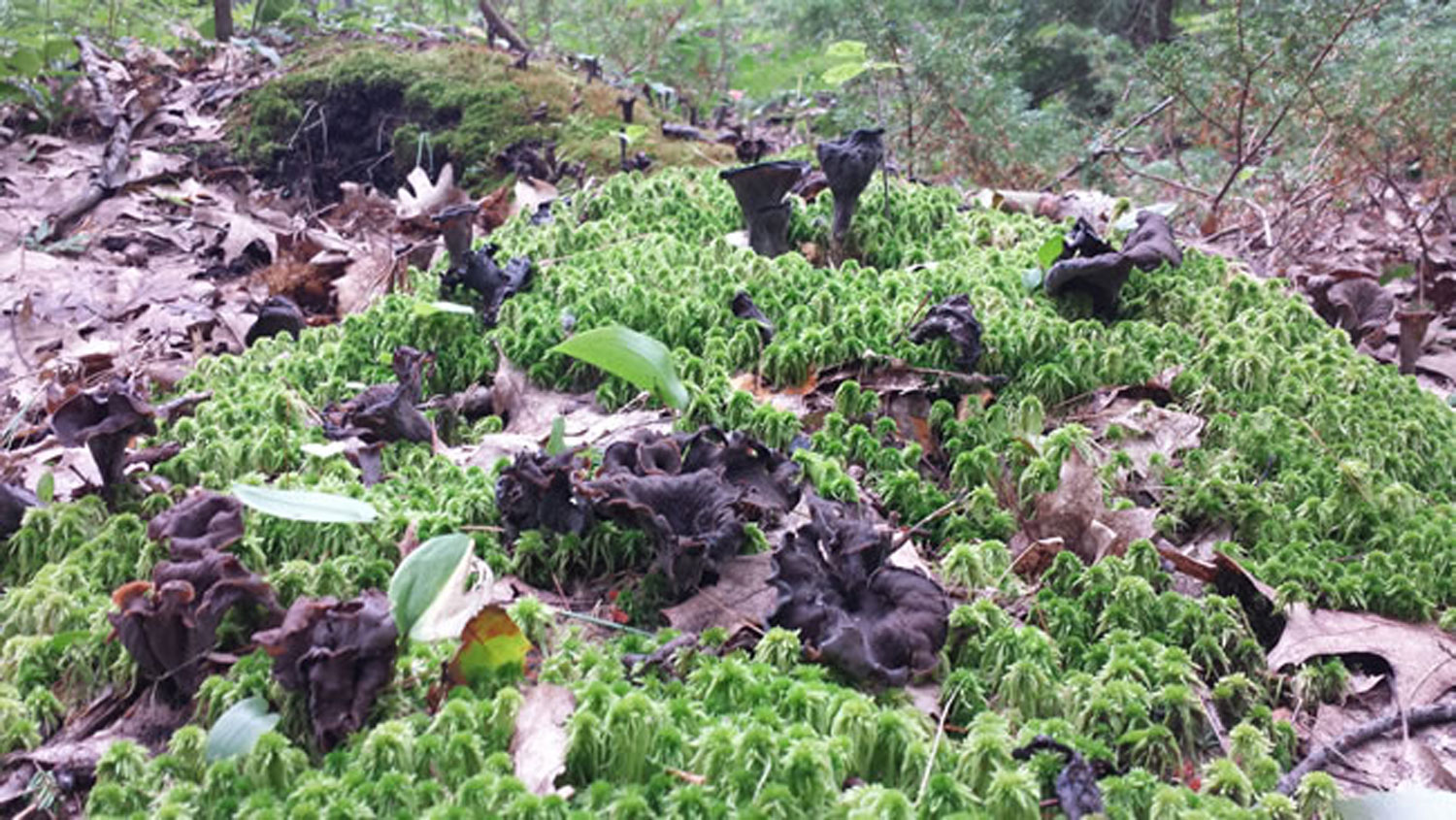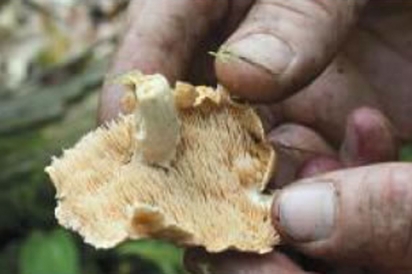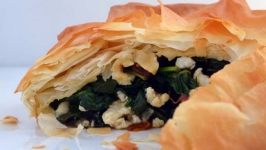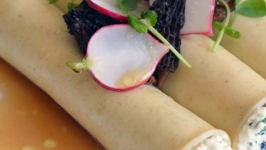Trumpets, Hedgehogs and Chanterelles: Tracking the Elusive Mushroom
It was midweek in Muskoka near the end of cottage season and hardly a car passed on the road outside a faded general store. A giant white pine spiralled dizzily above. My partner and I waited in the dusty parking lot at high noon to rendezvous with an expert tracker.
I'd already known the thrill of pursuing our delicious and potentially harmful quarry. It spends most of its existence underground or in dead trees, invisible, rarely emerging, preferring dank weather in late summer and early fall.
I had my first encounter on a rainy September weekend twelve years ago. Walking along the sinuous forest road behind my cottage, I found a dead tree covered with Pleurotus ostreatus—oyster mushrooms. They were gilled and smooth with an off-centre stalk, and stacked like shelves around the trunk of the rotten snag.
Wild mushrooms can be deadly. I knew that. But there are few foods I love as well as mushrooms. Oysters sautéed alone in butter are among my favourites.
There is a particular familiarity about foods we love: the flavour and aroma, but also the look, the texture, and how they feel on fingers and tongue. I had fondled these many times at the supermarket or over a steaming pan before gently settling them inside. In the bush they seemed utterly recognizable and yet whiter, firmer and more fragrant.
I had heard that wild oyster mushrooms are not easily mistaken for anything poisonous. Impetuously, I filled my arms with them. Back at the cabin they made an unforgettable, indulgent meal.
I was captivated, but would never again take such a risk. The rule is: if in doubt, don't eat it. Safe foraging demands a safe field guide.
Unfortunately, a book can't show you how and where to look. Over the years I have chanced upon morels. My family dined last Thanksgiving on delectable coral fungi, almost too beautiful to eat, from the woods near our cottage. But my finds have been few so I hoped to find a teacher. Fortunately, some acquaintances connected my partner Danny Ouelette and me to their foraging mentor.
To chef and mushroom tracker Patrick Louch every hunt is an adventure, but he takes no chances. His favourite choices are easily distinguishable. He agreed to share his expertise with us. Muskoka offers the best, most accessible mushroom foraging in Ontario, he said, so we made our plans to meet near Lake Joseph.
High noon. Right on time, Patrick arrived in a burly grey pickup. He'd driven all the way from Beamsville. The mixed coniferous and deciduous forest of oak, beech, maple, pine, cedar and hemlock of Muskoka provides Patrick's preferred habitat, which is why he was happy to drive the long distance from the Niagara Region.
Ancient woodlands thrive on a complex symbiosis between trees and fungi. Like vast neural networks, the mycelia spread under decomposing leaves. As a biology student in the 1980s, I took a particular interest in plant ecology and spent a summer job conducting a census of plant species in Ontario's fragmented Carolinian forest. At the time biologists were only beginning to probe the integral role of fungi. Now we know that healthy trees depend on them. This part of Muskoka still harbours pockets of old-growth forest, favouring mature soil ecology.
According to Patrick, "Mycelium is all those little tendrils and threads that some would say can be likened to [how in] Avatar, in that movie, the whole planet is intertwined as a single biological organism."
A local property owner lets him forage on some undeveloped land verging on Lake Joe. We jumped in the car and followed Patrick five minutes down a hilly road, parking in the turnaround at a dead end. Soon we were scrambling over pink granite hillocks festooned with shaggy grey lichen. The vales between were carpeted with plush wet sphagnum moss. The oak canopy was open and airy, shedding lots of warm sun.
We passed many typical gilled mushrooms with bright red, pale lilac or bluish caps which Patrick identified as members of the genus Russula. Some are edible, he said, but not worth the trouble: "In survival mode, I would go with that." He also stopped to show us boletes—also typical mushrooms but with a spongy texture instead of gills under the caps. Most are edible, too, he said, but were still not the reason he'd brought us here.
Then we saw another type. "Angela calls them LBJs," he related: "little brown jobs."
Patrick has been mushroom foraging since around 2001, when he received a random phone call from a woman named Angela Houpt, offering him wild mushrooms for his catering business. He happily bought a basket and then asked her to go with him for a walk in the woods. She agreed, and for the next few years she would take him on mushroom hikes. Other times he would discover a patch of mushrooms and call her to come over.
"She taught me how to learn, and how truly there is no rule of thumb when it comes to mushrooms, and if you're not 100 percent certain, you don't risk it. You take time to go through the identification process." Patrick then explained how to take a spore print for this purpose. You cut the cap, leave it on a sheet of white paper for a while, and the spores will drip down to create a little "fingerprint" of the mushroom. Distinctive visuals such as dark, light, pink, brown, yellow or white can help narrow identification to a particular group.
"Try to find the closest that you possibly can before you ever put a piece in your mouth. Because some of them out there are deadly," cautions Patrick. Angela's so-called LBJs are often the psychoactive kind, he advised. "I don't advocate foraging mushrooms so we can get high. That's not my thing."
We had come to the right place and mild, rainy weather had provided ideal conditions but, as we continued through the woods, we were not finding what he wanted. This is part of the intrigue. Unlike wild herbs or blueberries, fungi spread in secret. For twelve years I have passed the place on the road where I found those oyster mushrooms, but the tree is gone and that particular feast will never reappear. Someday they'll appear somewhere else.
The largest living thing on Earth, and more than two thousand years old, is reported to be a colony of honey fungus covering 880 hectares in an Oregon forest. Small, fruiting bodies appear only on mature organisms when conditions are right, maybe hardly at all, after a hot, dry summer.
"The nice thing about foraging is, it's not a quick walk through the forest. You're looking for a little cup of glory," Patrick remarked. Approaching a large pond, we trudged downward into deeper shade and a brigade of late mosquitoes. Patrick halted, overlooking a dim hollow.
"Oh, Shazam, here we go! Beautiful!"
He'd found the first clump of black trumpets, Craterellus fallax. George Barron's Mushrooms of Ontario and Eastern Canada, a reliable field guide that offers good notes on what's edible and what should be avoided, calls these "horns of plenty."
They're thin-fleshed, dark brownish-grey, paler underneath, and flared like a trumpet—"a little village growing out of the moss," Patrick enthused. We squatted to gather some. He used two hands to pinch off each mushroom and to avoid pulling anything up out of the ground.
"You're not hurting the organism underneath," he explained. "We just pick the fruiting bodies. If there are old ones you leave those, and if there are super young ones I leave those so they continue to grow."
He planned to use some for Simply Sexy Food, his catering business. Danny and I collected a few, too. I asked Patrick how best to use them. "They might go into a marinated mushroom salad, which I love to do with a little bit of maple and blueberries," he responded. "Or with a great demi-glace sauce or red wine mushroom reduction. Maybe a little mushroom gorgonzola cream sauce. But then again, in a great mushroom omelette. And, of course, soup. But I've even in the past had some mushrooms so big I was able to stuff them with quinoa and cheese, and then a light, light roast in the oven to soften them up, just enough to warm up the inside a touch.
"We're limited only by our own creativity. I'm a huge advocate of cooking without recipes and encouraging playfulness. There are no mistakes, only unexpected results."
A little farther on, Patrick yelped again. Black trumpets were becoming more abundant, spreading in indistinct lines across the forest floor. He also found little bright golden-orange chanterelles. Next he spotted hedgehog mushrooms. They're chunky, knobby and pale brown. He flipped the cap, revealing distinctive fine teeth instead of gills underneath.
But it was Danny who spotted the most beautiful mushroom we'd seen: straight, white and graceful. Patrick used a small spade to gingerly extract its bulb-shaped base from the mulch of hemlock needles. He pointed out the distinctive frilly collar and typical gills. It was a deadly amanita—an essential part of our lesson. After handling it, he rubbed sphagnum moss over his hands to clean them.
Patrick was exultant to have found so many things within some ten square metres of ground.
"This is a nice little patch. There have been times when I would go out into the forest and fill two buckets and my apron, and there were times when I went out with the cooks and we'd come back with a table load of mushrooms. Sometimes the temperature and the moisture and everything is right, and there would be a carpet of them."
After filling a bucket, Patrick wanted to spend the rest of the afternoon foraging. But first he took us back to the truck, pulled out a portable cooker, and sautéed a mixture of black trumpets, hedgehogs and chanterelles in butter for Danny and me to sample. Delicious and gratifying.
The northern woods provide the optimal situation, but some wild mushrooms even grow in city parks. One of Patrick's favourite mushrooms—chicken of the woods—forms sulphur-yellow brackets on living trees, especially oaks. Morels appear under white pines in late spring, while the first chanterelles appear in midsummer. But the best time of year to look for most varieties is from late August until the first frost.
Several years ago in Guelph's Preservation Park I found a fallen tree covered with oyster mushrooms. I'll watch for them again this year, but now I look forward to expanding my repertoire.









